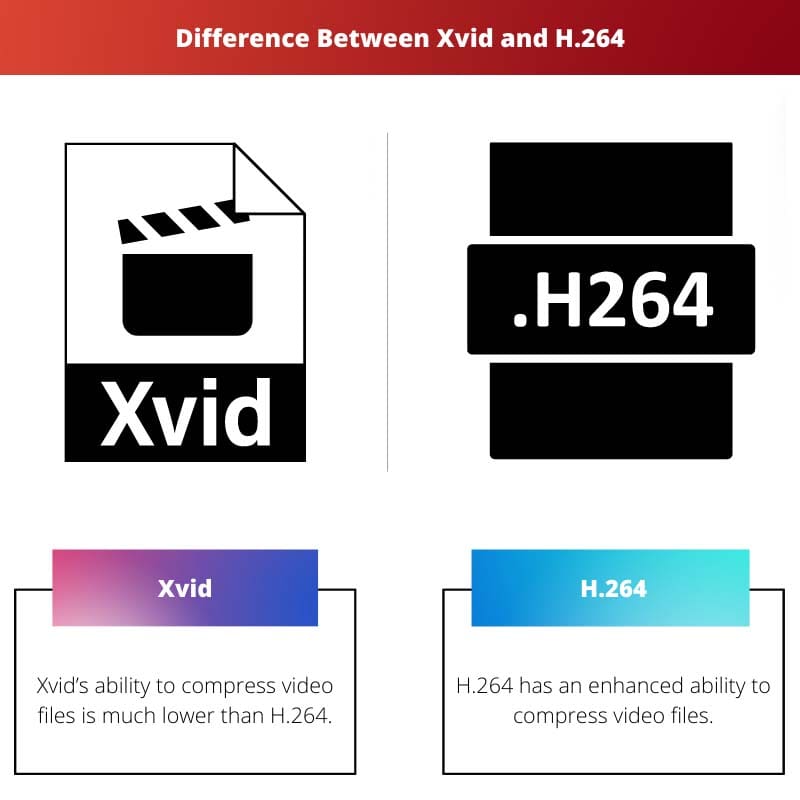The superior compressive strength of H.264 allows the user to significantly reduce the size of a video file by 80% without compromising its quality.
Sometimes the codec also improves the quality of the video file by compressing it. Conversely, the Xvid codec also compresses a video file’s size but cannot reduce its size as significantly as the H.264 codec.
The quality of the compressed files also tends to be inferior to those compressed with the H.264 codec.
Key Takeaways
- Xvid and H.264 are video compression standards used to reduce the file size of video content.
- Xvid is an older standard largely replaced by H.264, which offers better compression and higher video quality at lower bit rates.
- H.264 is widely used in video streaming services, while Xvid is still used in some older video codecs.
Xvid vs H.264
The difference between Xvid and H.264 is that while the H.264 codec has an augmented ability to compress video files, Xvid’s ability to compress video files is much lower. Although both Xvid and H.264 are lossy video compression codecs, their ability to compress data is quite different.

Comparison Table
| Parameters of Comparison | Xvid | H.264 |
|---|---|---|
| Compression Ability | Xvid’s ability to compress video files is much lower than H.264. | H.264 has an enhanced ability to compress video files. |
| Quality | The quality of the compressed file may be compromised. | The quality of the compressed file is not compromised. |
| Encoding Speed | Xvid can be encoded at a relatively higher speed than H.264. | H.264 needs a longer time to be encoded. |
| Decoding Ability | Most devices cannot decode the Xvid codec. | Most devices can decode the H.264 codec. |
| Processing Power Requirements | The processing power requirements are not that high. | The processing power requirements are much higher. |
| Quad Processor | Quad processors are not needed. Xvid also works well with weaker processors. | Quad processors are needed to provide the extra processing power to encode and decode files. |
| Compatibility | The Xvid codec is most compatible with older devices. | The H.264 codec is compatible with most modern devices. |
What is Xvid?
Xvid is a well-known open-source codec, initially released in 2001. Originally it was developed as an outgrowth of the DivX codec.
Xvid has reigned supreme in the lossy compression codec arena for quite a long time. As an alternative codec library, Xvid follows the MPEG4 standard.
Its reputation had surpassed the popularity of the DivX codec.
It was hailed for its ability to encode and decode video files even on weaker processors. Moreover, the Xvid codec allows users to encode and decode files at a relatively enhanced speed level.
Older players are more attuned to the Xvid video codec. This reduces its usability in the modern age.
However, a significant drawback of the format was that sometimes it severely compromised the quality of the compressed video file.
This deterred users from extensively implementing it and fueled the search for an improved version.
What is H.264?
H.264 is one of the most popular lossy video compression formats available.
Initially, the codec was released in 2003 due to a joint endeavour between ITU-T’s Video Coding Experts Group and the ISO/IEC Moving Picture Experts Group (MPEG).
It subsequently gained acclaim for its efficient compressing abilities that reduced the size of the video file by 80% without affecting the quality of the final output.
The only downside with this advanced codec is that its algorithm requires a lot of processing power and time to encode files. Initially, the H.264 codec was also used to compress Blu-ray discs.
Users with weaker processors may not find this codec very useful. Quad processors are best suited for using the H.264 codec.
This high-quality codec is compatible with mobile phones and other digital video players.
Main Differences Between Xvid and H.264
- The main difference between Xvid and H.264 is that H.264 has a significantly better compressive ability than Xvid. It can create smaller video files without compromising the quality of the visual and audio outputs. However, the Xvid codec cannot reduce the video file size as much as the H.264 codec.
- Device manufacturers do not always support Xvid due to its tainted reputation of being used extensively by video piracy conglomerates. On the other hand, H.264 is the standard format used by most devices. Thus, the two differ in the devices and platforms that support each.
- The processing power needed to encode or decode an H.264 file is much higher. Its superior compression ability is accompanied by an amplified processing power requirement much higher than the Xvid codec’s power requirement.
- H.264 offers better quality output than Xvid. The H.264 codec compresses video files without compromising their output quality.
- Xvid can be encoded within a shorter period. Conversely, H.264 takes much longer to encode. This is H.264 codec’s most significant and only conspicuous drawback.
- Quad processors may be the most befitting processors to run the H.264 codec, as they can easily supply the excess power needed. While the Xvid codec works quite well on devices with weaker processors.

- https://ieeexplore.ieee.org/abstract/document/4604423/
- https://www.diva-portal.org/smash/record.jsf?pid=diva2:830797